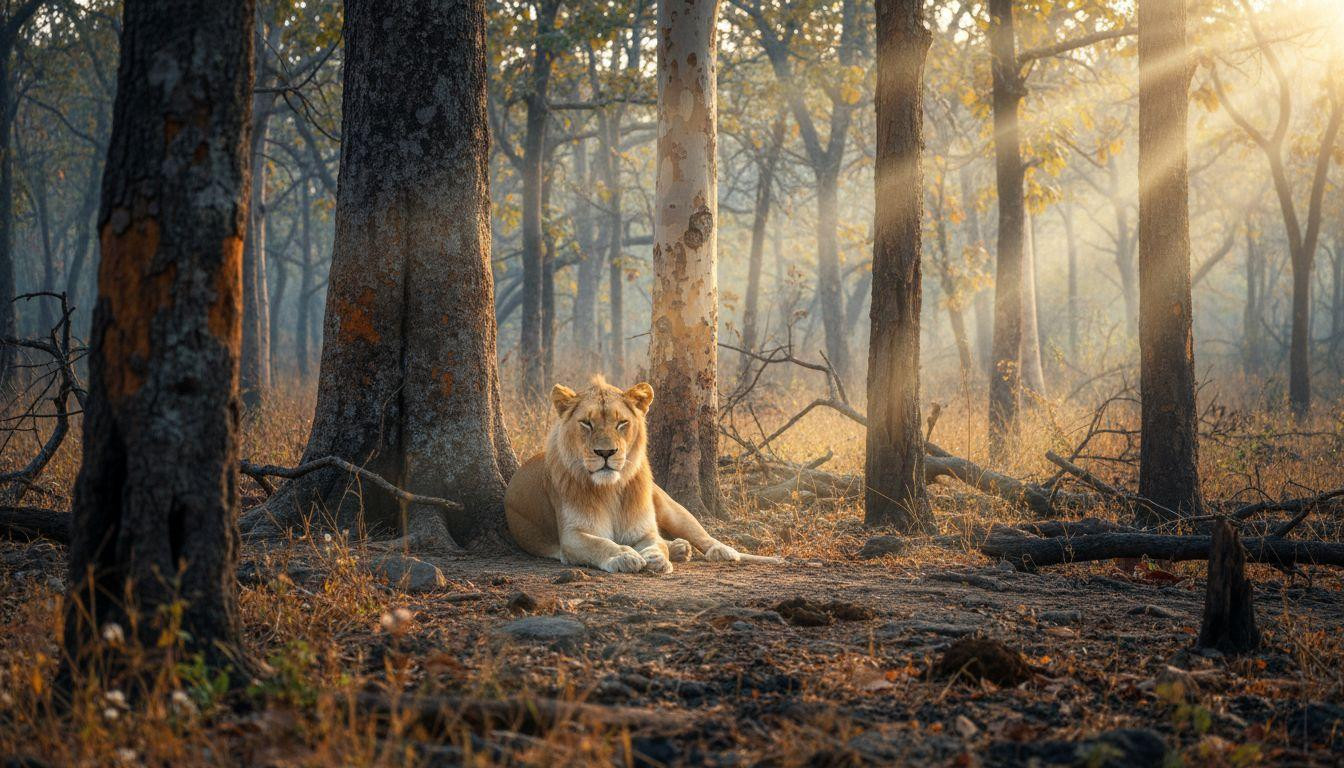While Africa’s legendary safari destinations capture imaginations worldwide, India’s Gir National Park offers something no African reserve can match: the world’s only wild Asiatic lions. These cream-colored cats roam dense deciduous forests just 240 miles from Ahmedabad, accessible without intercontinental flights or $2,000 daily lodge fees. November 2025 marks the perfect arrival window. The monsoons have ended, vegetation glows emerald, and President Draupadi Murmu’s October visit officially opened the 2025-26 season.
Why African safaris demand reconsideration
African safaris present undeniable logistics challenges that impact even experienced travelers. Daily park fees reach $300-500 per person in Tanzania and Kenya’s premier reserves. Luxury lodges command $800-1,500 nightly rates during peak seasons.
International flights from major US cities average $1,200-1,800 to reach Nairobi or Johannesburg. Internal connections add another $400-600 for remote airstrips. Yellow fever vaccinations remain mandatory for most East African destinations.
Crowd management creates additional concerns. The Serengeti hosts over 500,000 annual visitors. During peak migration months, 15-20 vehicles often surround single lion prides. Conservation-focused parks elsewhere offer more intimate wildlife encounters without the circus atmosphere.
Gir National Park: the Asiatic lion’s last stand
Gujarat’s Gir National Park spans 545 square miles of protected sanctuary. Within this compact territory live all 674 remaining wild Asiatic lions on Earth. The species recovery from fewer than 200 individuals in the 1960s represents conservation’s greatest success story.
A conservation miracle you can witness
Historical hunting nearly eliminated Asiatic lions across their former range spanning the Middle East and Central Asia. Only the Nawab of Junagadh’s protection preserved the final population. His former hunting grounds became India’s premier wildlife sanctuary in 1965.
Today’s lion density reaches 0.48 animals per square mile versus the Serengeti’s 0.1 lions per square mile. Concentrated populations mean 95% sighting success rates during morning safaris. Professional naturalists report encounters within the first hour of most excursions.
The landscape that lions call home
Dense deciduous forests create intimate safari experiences impossible in African savannas. Teak, dhok, and khair trees form cathedral-like canopies filtering golden morning light. November’s post-monsoon conditions produce peak photographic opportunities.
Kamleshwar Dam anchors the sanctuary’s eastern section. This reservoir concentrates wildlife including 300 bird species, marsh crocodiles, and over 40 reptile varieties. India’s western coast offers additional natural experiences within driving distance.
The price reality: $145 versus $500 per day
Gir’s economic advantages become apparent immediately. Private jeep safaris cost $145 for three-hour excursions accommodating up to six adults. This all-inclusive rate covers permits, vehicles, and qualified naturalist guides.
Safari cost breakdown
Foreign visitors pay approximately $80 for weekend safari permits versus $300-500 daily African park fees. Vehicle rentals add $43-55 depending on group size. Professional guides command $5-9 per safari.
Accommodation ranges from $24-36 for basic guesthouses to $120+ for premium properties in Sasan Gir village. Restaurant meals cost $2.40-18 versus $50-100 at African safari lodges. Total daily expenses rarely exceed $200 per person.
Accessibility advantage
Domestic travel eliminates international flight complexities. Ahmedabad serves as the regional aviation hub 235 miles from Gir. Junagadh railway station connects directly to Mumbai, Delhi, and Ahmedabad with 90-minute drives to safari entry points.
November through March provides optimal weather conditions with temperatures ranging 72-90°F. Cost-effective wildlife experiences elsewhere demonstrate similar accessibility benefits over international alternatives.
What you’ll experience at Gir
Open-roofed jeeps navigate forest trails during three daily time slots: 6-9 AM, 8:30-11:30 AM, and 6 PM. Dawn safaris offer peak wildlife activity as temperatures remain comfortable and golden hour lighting creates spectacular photography conditions.
Safari encounters beyond lions
Asiatic lions share territory with Indian leopards, sambar deer, chital, nilgai antelopes, and striped hyenas. King cobras and Russell’s vipers represent the sanctuary’s 40+ reptile species. Bird enthusiasts document hundreds of resident and migratory species.
The 412-hectare Devaliya Interpretation Zone provides educational context about ecosystem conservation. This enclosed area guarantees wildlife sightings for visitors with limited time while supporting the broader sanctuary’s research programs.
Cultural immersion opportunities
Gujarati cuisine emphasizes vegetarian traditions reflecting local conservation values. Dhokla, thepla, and khichdi represent regional specialties available at village restaurants. The Maldhari pastoral community maintains traditional lifestyles while coexisting peacefully with lion populations.
Somnath Temple stands 31 miles southeast, offering spiritual experiences alongside wildlife encounters. Sacred natural spaces throughout India combine conservation with cultural significance.
Planning your Gir safari adventure
Online booking through girlion.gujarat.gov.in opens 30 days before desired safari dates. Advance reservations prove essential during peak season from November through March. Arrive at reporting centers 30 minutes early with valid photo identification matching booking records.
The 2025-26 season officially began with President Murmu’s October visit, generating heightened interest among international travelers. Local authorities upgraded visitor facilities and enhanced safety protocols following the presidential tour.
Your questions about Sasan Gir and Gir Forest, India answered
What’s the best time to visit for lion sightings?
November through March provides optimal conditions with comfortable temperatures and concentrated wildlife around water sources. Morning safaris from 6-9 AM offer highest success rates as lions remain active during cooler hours before seeking shade.
How do Asiatic lions differ from African lions?
Asiatic lions display shorter, sparser manes revealing distinctive ear outlines. Males weigh 350-420 pounds versus African lions’ 420-550 pounds. A unique longitudinal skin fold runs along their bellies, absent in African subspecies.
Why choose Gir over African safari destinations?
Gir offers the world’s only wild Asiatic lion population at 60-70% lower costs than comparable African experiences. Domestic accessibility eliminates international flight requirements, visa complications, and mandatory vaccinations while providing more intimate wildlife encounters.
Dawn light filters through sal trees as lion cubs practice hunting techniques beside Kamleshwar’s still waters. November mornings at Gir reveal conservation success stories that Africa’s vast savannas cannot replicate. The last Asiatic lions call this forest home.
